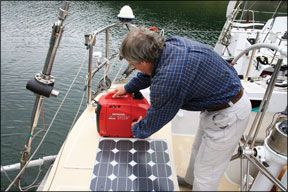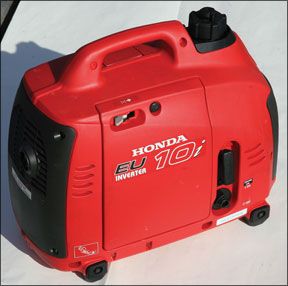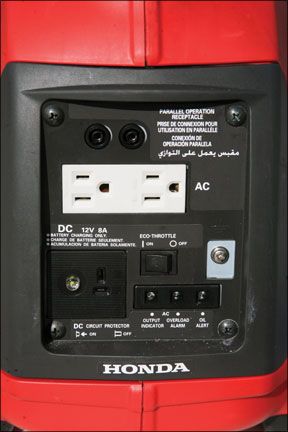Bluewater voyagers and Practical Sailor contributors Evans Starzinger and Beth Leonard put the Honda EU1001 gas-powered generator, Hondas smallest super quiet four-stroke generator, through its paces during an extended cruise of Southern Chile. They report that the 1,000-watt generator is well engineered and essentially maintenance free. Wanting to go months without running the engine and unable to depend on wind and solar power in Chiles Beagle Channel, the couple chose the lightweight generator to feed their onboard battery-charging needs. The Honda will run for approximately eight hours on less than a gallon of gas, and its noise level was measured at a mere 59 decibels, quieter than normal conversation.
****

Photos by Beth Leonard and Evans Starzinger
The EU1000I is the smallest of Hondas line of “Super Quiet” generators. The four-stroke generator was the lightest and quietest of the five portable gas-powered gensets Practical Sailor reviewed in the March 1, 2005 issue. (The Yamaha EF1000iS was named Best Choice in that test.)
The Honda will produce 900 watts continuously (1,000 watts intermittently) and weighs only 28 pounds. It will run for approximately eight hours on three-fifths of a gallon of gasoline. The 2005 test measured its noise level at 59 decibels (regular conversation is about 60)-6.5 decibels quieter than the Yahama EF1000 is.
After talking with three Honda genset owners who had six years or more on their generators, my partner, Beth Leonard, and I decided to purchase the EU1000I as we were planning to winter in Chiles Beagle Channel and realized our electrical system would be out of balance.
Our solar panels would not get much sunlight, and we would be spending weeks at a time without running the engine. A wind generator would not be useful because there is zero wind in a good Chilean cove. I was adamantly opposed to a diesel genset because of the weight, maintenance, and expense.

]The Honda is well engineered and essentially maintenance free. What maintenance is required is easy. The EU1000I takes a cup or so of standard 10W30 motor oil, which needs to be changed about every 100 hours. This is a bit fussy, because of the overly compact design of the oil drain/fill port. There is no oil filter. The carburetor may need to be drained if the fuel gets contaminated; this is done by turning a set screw, letting some fuel drain and then tightening the screw back up. The sparkplug can be cleaned or changed, but from what weve heard, this is rarely needed. However, when our Honda became difficult to start, we changed out our regular spark plug for a cold-weather spark plug. Problem solved.
The generator has a low-oil alarm and an automatic cut-off switch. This works perfectly, so long as the boat is not rolling heavily. Otherwise, the alarm will trip at every roll. You can disconnect a wire to disable the low-oil cut-off if youre using the generator underway, but its not recommended.

If you consider buying the Honda or other small generator:
Match your battery charger to the generators output. Hondas specs suggest the EU1000I can power a 35-amp battery charger, but that is a very conservative rating. We can get 47 amps from our 50-amp battery charger, but over 47 amps, the Honda overloads and automatically shuts down.
Find a safe location for stowing the generator. Anyone carrying an outboard motor has already crossed the Rubicon of stowing gasoline somewhere on board, so carrying a gasoline genset does not introduce much additional safety hazard. The gasoline jugs should be carried either on deck or in a locker isolated from the interior that is vented overboard with no potential source of spark.
Find a safe location to operate it. Because of the open exhaust, the generator needs to be run outside in the open air, downwind from any hatches on your or your neighbors boat. (Carbon monoxide is a killer.) We place it either at the helm or the swim platform and run an extension cord from it to our battery charger.
We have found the EU1000I to be the ideal solution to meet our high-latitude extra charging needs. It is compact, reliable, fuel efficient, and relatively quiet.
Evans Starzinger and Beth Leonard have sailed more than 85,000 bluewater miles together. They are frequent contributors to various sailing publications. The couple is currently aboard Hawk, a custom 47-foot aluminum sloop, cruising South Georgia.


































Are there any ‘polarity’ issues that you need to worry about when running the honda 1000 into your boat? Thank you